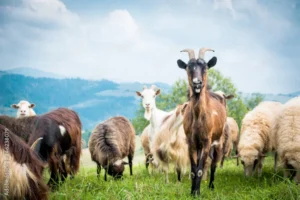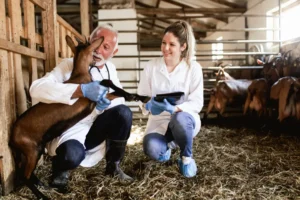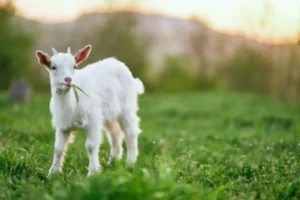 The goats are coming! The goats are coming! A surge in goat production, especially dairy goat production has been going on for the past decade. Dairy goat population increased by 61 percent between 2007 and 2017, according to the U.S. Department of Agriculture. What’s the attraction to goats? For small farmers, hobby farmers, and homesteaders alike, goats can be a great choice for the production of milk, meat, fiber and more. The Drinking Post automatic waterer is perfect for goats. Think of your new Drinking Post as the smart replacement for your old goat trough.
The goats are coming! The goats are coming! A surge in goat production, especially dairy goat production has been going on for the past decade. Dairy goat population increased by 61 percent between 2007 and 2017, according to the U.S. Department of Agriculture. What’s the attraction to goats? For small farmers, hobby farmers, and homesteaders alike, goats can be a great choice for the production of milk, meat, fiber and more. The Drinking Post automatic waterer is perfect for goats. Think of your new Drinking Post as the smart replacement for your old goat trough.
Goats need plenty of fresh water – up to 4 gallons a day for lactating females (does). What’s the best ways to provide water to your goats? We think you’ll like the advantages of a Drinking Post Automatic Waterer for goats and other livestock. We’ve compiled a list of the top five goat watering systems.
Ready for your daily workout? Hauling buckets full of water to a goat trough is a common method of providing water. Depending on the size of your operation, you may need to haul buckets multiple times a day, especially in hot weather. The advantage to buckets and goat troughs is the low up-front cost. The downside is the time and energy needed for hauling water, plus the added danger of treacherous footing on frozen or muddy ground.
Natural water from a creek or pond is a wonderful luxury to have when raising goats. Your animals can drink freely, and your efforts may be minimal. One dangerous disadvantage is that open water sources can be contaminated easily with urine, feces and debris making it unfit for consumption. Before you allow goats to drink from any water source, first verify that it is safe.

Instead of hauling water to goats, some farmers choose to run a simple hose to the goat trough. Some will even automate the process further by adding a float valve to automatically fill the trough when it reaches a certain level. The main enemy of the hose and trough method is freezing temperatures. Once water freezes in your hose or the trough, you’re right back to hauling water manually and breaking any ice on the standing water in the trough.
Yes, you heard us right. Heated buckets. Heated buckets, using extension cords to provide electricity to the enclosed heater coil solves the issue of standing water freezing in cold air. Though much smaller and portable, they can be compared to heated water tanks because of their use of electric heating elements. Simply haul the electric bucket with its trailing extension cord and place it on the ground for your goats to drink from. Remember to use extra caution when employing buckets with heating elements in any barn setting. Their small size and fragility make them vulnerable to rough handling by the animals and possible accidents from frayed wires or overheating elements that can pose a fire hazard. It’s is important to note that heating systems are the leading cause of barn fires.

The best choice of all is the installation of Drinking Posts to provide unlimited fresh water for your goats. A Drinking Post automatic livestock waterer works and installs like the more familiar frost-free yard hydrant. By keeping the operating valve of your Drinking Post 18 inches below the frost line, your Drinking Post works all year long even in the coldest months. No electricity means you need not worry about the inherent fire and electrocution risks. Plus, as a direct result, no electric heating element means lower electric bills
Because a Drinking Post provides water when your animal needs it you no longer need to haul water buckets or run a hose line. Best of all – your Drinking Post Goat Watering System comes with a 5-year warranty. Isn’t it time to bring the convenience and value of a Drinking Post to your livestock? So, whether they are goat, sheep, horse, swine, cattle, or alpaca, you can start here today. To learn all the benefits of Drinking Post waterers visit https://dpwaterer.com/automatic-waterer-guide/
2 Responses
Hi Tyrone, good luck on your farming journey! I’m glad you’re looking into new and innovative products like the Drinking Post. That will make things easier for you! We give away a free Drinking Post each month, if you’d like to enter the contest, follow this link: dpwaterer.com/contest/
very helpful information for me, i’m a small beginner farmer, of three nigerian drafy goates, this is a big change from having 8 to 15 cows and a horse’s and two dozens of chicken, and 4 hogs since as a child. I have moved back home where i grew up at as a child. this 100 plus acrages tree farm is over 400 years old, and it has grown thick and wild since i been away, i’m back home now attempting to start over, there’s 4 ponds on the place and they each needs re-digging and needs new fishes. but right now i’m just focuesing on cleaning up this over grown area so i can see some distance, no cows or horses or pigs been here in the pass 20 years i have been away, but thats all about to change as i educate myself and wife and my young family, i’ll be watching for emails from you all very soon, my mother is disabled, and grand dad is no longer with us. to show us hands on. God Bless You.